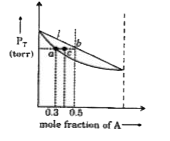Water saturated with air (20% 0, and 80% N) at 1 atm and 298 K contains 8.9 x 10^-3 g/ L dissolved oxygen. Its solubility under 25 atm pressure of will be a)8.9 × 10 − 3 g L − 1 b)1.1125 g L − 1 c)1.5642 g L − 1 d)1.834 × 10 − 2 g L − 1 Solution in Malayalam
8.9×10−3gL−1
1.1125gL−1
1.5642gL−1
1.834×10−2gL−1
The correct Answer is:B
Since p=kHc, we have 0.20 atm =kH(8.9×10−3gL−1)and25atm=kHc
Hence c=(8.9×10−3gL−1)(25atm)/0.20atm=1.1125gL−1
Topper's Solved these Questions
- BOOK - BRILLIANT PUBLICATIONCHAPTER - SOLUTIONSEXERCISE - Level II50videos
SOLUTIONS
- BOOK - BRILLIANT PUBLICATIONCHAPTER - SOLUTIONSEXERCISE - Level II (Assertion & Reason Type)20videos
SOLUTIONS
- BOOK - BRILLIANT PUBLICATIONCHAPTER - SOLUTIONSEXERCISE - Level-III (Linked Comprehension Type)12videos
SOLUTIONS
- BOOK - BRILLIANT PUBLICATIONCHAPTER - SOLID STATEEXERCISE - LEVEL-3 (Linked Comprehension Type)10videos
SOLID STATE
- BOOK - BRILLIANT PUBLICATIONCHAPTER - STEREOCHEMISTRY EXERCISE - LEVEL-II (ASSERTION - REASON TYPE)2videos
STEREOCHEMISTRY
Similar Questions
The volumes of two HCl solutions A (0.5N) and B(0.1N) to be mixed for preparing 2 L of 0.2 NHCl are:
03:07View SolutionAssertion : If a liquid solute more volatile than the solvent is added to the solvent, the papour pressure of the solution may increase i.e. ps>p∘.
Reason In the presence of a more volatile liquid solute, only the solute will form the vapours and solvent will not.01:30View Solution1 mole of A and 1 mole B are mixed together to form an ideal solution at 25∘C. Solution is placed in a vessel fitted with piston. If pressure on the solution is reduced isothermally.

Correct relationship between P∘AandP∘B is01:30View SolutionF centre is an example of metal excess defect due to the presence of extra cations at interstitial sites. Zinc oxide is white in colour at room temperature, on heating it loses oxygen and turns yellow.
ZnOHeat−−→Zn2++12O2+2e−
Now there is excess of zinc in the crystal and its formula becomes Zn1+x O. the excess of Zn2+ ions move to interstitial sites and the electrons to neighbouring interstitial sites.
There are many solids which are difficult to prepare in the stiochiometric composition and contain less amount of the metal as compared to stiochiometric proportion. a typical example of this type is FeO which is mostly found with a composition of Fe0.95. it may actually range from Fe0.96 O.
Q. In Fe0.95 O:06:23View SolutionAssertion : Meso tartaric acid is optically inactive
Reason : Meso tartaric acid has a plane of symmetry04:11View SolutionThe solubility of BaSO4 in water is 2.42×10−3gL−1 at 298K. The value of its solubility product (Ksp) will be (Given molar mass of BaSO4=233gmol−1)
04:09View SolutionThe osmotic pressure of solution containing 34.2 g of cane sugar (molar mass = 342 g mol^(-1) ) in 1 L of solution at 20^(@)C is (Given R = 0.082 L atm K^(-1) mol^(-1) )
05:28View SolutionThe osmotic pressure of solution containing 34.2g of cane sugar (molar mass = 342 g mol−1 ) in 1 L of solution at 20∘C is (Given R=0.082 L atm K−1mol−1 )
04:29View SolutionThe solubility of BaSO4 in water is 2.42×10−3g⋅L−1 at 298 K . The value of its solubility product (Ksp) will be
(Given molar mass of BaSO4=233g⋅mol−1)04:33View SolutionCalculate the total pressure in a 10 L cylinder which contains 0.4 g of helium, 1.6 g of oxygen and 1.4 g of nitrogen at 27^(@) C. Also calculate the partial pressures of He gas in the cylinder. Assume Ideal behaviour for gases. R = 0.082 L atm k^(-1) mol^(-1)
03:42View SolutionCalculate the total pressure in a 10 L cylinder which contains 0.4 g of helium, 1.6 g of oxygen and 1.4 g of nitrogen at 27^(@) C. Also calculate the partial pressures of He gas in the cylinder. Assume Ideal behaviour for gases. R = 0.082 L atm k^(-1) mol^(-1)
02:02View SolutionCalculate the total pressure in a 10 L cylinder which contains 0.4 g of helium, 1.6 g of oxygen and 1.4 g of nitrogen at 27∘C. Also calculate the partial pressures of He gas in the cylinder. Assume Ideal behaviour for gases.
R = 0.082 L atm k−1mol−102:33View SolutionCalculate the total pressure in a 10 L cylinder which contains 0.4 g of helium, 1.6 g of oxygen and 1.4 g of nitrogen at 27^(@) C. Also calculate the partial pressures of He gas in the cylinder. Assume Ideal behaviour for gases. R = 0.082 L atm k^(-1) mol^(-1)
03:53View Solution1 atm और 298 K पर साम्य H2O(l)⇔H2O(g) के लिए
01:57View SolutionCalculate the total pressure in a 10 L cylinder which contains 0.4 g of helium, 1.6 g of oxygen and 1.4 g of nitrogen at 27^(@) C. Also calculate the partial pressures of He gas in the cylinder. Assume Ideal behaviour for gases. R = 0.082 L atm k^(-1) mol^(-1)
View Solution

